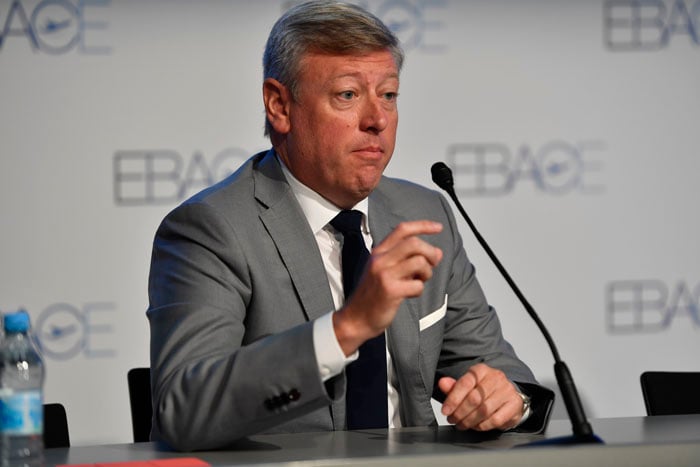
Matteo Mirolo, head of contrail policy and strategy at Breakthrough Energy, said “business aviation not only can but must supercharge” its climate-impact work.
GENEVA—ForeFlight, the Boeing-owned provider of electronic flight bags and other integrated software solutions for aviation, has announced a partnership with climate and clean-energy group Breakthrough Energy that both parties believe may soon enable business aviation customers to reroute flights dynamically to avoid areas in which contrails are formed.
This could enable the nearest thing aviation can get to a quick and easy win in its sustainability battle. The Intergovernmental Panel on Climate Change estimates contrails may account for more than a third of aviation’s impact on global warming. The system the companies are developing relies on existing technology and could be deployed rapidly and relatively straightforwardly—but implementation will not happen overnight.
“I think the approach here is that of humility—humility toward the complexity of a very big, complicated issue,” Matteo Mirolo, head of contrail policy and strategy at Breakthrough Energy, told media during a pre-EBACE 2024 press conference here May 27 to announce the partnership. “It is potentially an extremely cost-effective way to have aviation make an impact—but that doesn’t mean it’s easy to do.”
The concept, at least, is clear enough. By analyzing data from satellites and meteorological data, and overlaying a thorough understanding of the conditions in which water vapor is likely to condense around soot particles produced by jet engines, Breakthrough Energy can produce a constantly updated map of areas in the atmosphere where contrails are likely to form. When this feed is integrated into ForeFlight’s flight-management tools, dispatchers, controllers and pilots will be able to see which areas and altitudes to avoid.
Eventually, the ForeFlight application should calculate both the extra cost of additional fuel needed to reroute the airplane around those areas and the additional carbon that would be emitted in doing so. If the equation makes sense financially and in terms of reducing carbon—and assuming air traffic controllers can accommodate the request—the pilot could then select the alternative flightpath.

The integration rollout will begin by letting users of the ForeFlight Dispatch system see visualizations of the contrail formation areas. The calculation element would follow. For the two companies, the challenge is not technical. Rather, they will have to demonstrate that their concept and the information on which it relies are robust and work to educate their several intended audiences.
“We need to be basically sure that when we say a contrail is going to form, it’s going to form,” Mirolo said. “That requires better, more granular, understanding of the atmospheric physics; it requires a better way of validating data. [But] that’s absolutely not a showstopper. It’s a variable that needs to be taken into account to further the research agenda.
“And then you go into what I would call maybe nonscientific areas of work,” he continued. “How do you make sure this is all compatible with the congested sky? How do you get pilots interested in this involved? There’s almost a psychological element there. I don’t doubt that pilots would really like it—but one needs to explain it to make them involved in it. And it’s not just pilots, but all the different experts that you need to have in operating an aircraft or an airline. And then you have the question of finances, as always, in any climate solution. Well, this is an extremely cost-effective one, but there’s still a cost. So who pays for it?”
Business aviation is potentially an ideal operational environment in which to prove the concept and its application, the companies argue. Kevin Sutterfield, ForeFlight’s chief revenue officer, highlighted two characteristics that make the sector an obvious first choice for the system rollout.
“One is innovation; the other is flexibility,” he said. “This industry in particular is adept at thinking ahead. And oftentimes, [business aircraft] have much more ability to move routes and climb to altitudes [where contrail formation can be avoided]. That may not always be true of some commercial aviation, fixed between two points and flying a known route.”
Luxaviation, an existing ForeFlight customer, is interested in using the system, and there is optimism that other early adopters will soon make themselves known. ForeFlight is not ready to commit to a timeline for the system rollout, but integration with the company’s other tools is a high priority, and Sutterfield says deployment is “months, rather than years” away. Certainly, Mirolo argued, business aviation entities ought to be strongly motivated to take a step that offers a quick and less expensive means of reducing the damage the sector is doing to the environment.
“It is obvious that there is mounting pressure on the business aviation sector to do its share of the work to [reduce] global warming,” he said. “I believe that business aviation not only can but must supercharge the work to reduce aviation’s carbon impact. Contrails [are] probably one of the easiest ways for business aviation to have a positive impact.”
